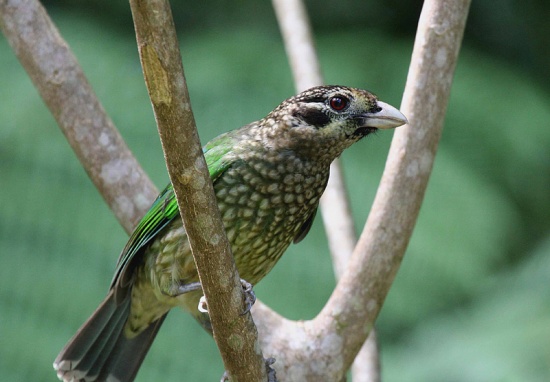- Ailuroedus maculosus
Identification
29cm.
- Emerald green plumage, paler below
- Heavy whitish spotting on head, underparts and mantle
- Whitish head with black markings
- Tail, greater coverts and secondaries finely tipped white
- Whitish bill
- Red eye
Sexes similar, females are slightly smaller
Similar Species
Green Catbird can appear similar but has a more or less uniform green head. White-eared Catbird is smaller, has an unmarked brown crown and a distinctive white ear-patch.
Distribution
Found in eastern Queensland (Atherton Tablelands to Burdekin River), Australia.
Common and widespread in its range.
Taxonomy
This is a monotypic species.
Huon Catbird, Black-capped Catbird, Northern Catbird, Arfak Catbird and Black-eared Catbird were formerly considered conspecific with this species.
Habitat
Tropical rainforest in lowlands and mountains. Also tall secondary growth, gardens and orchards. Occurs from sea-level up to 1540m in Australia.
Behaviour
Feeds mostly on fruits. Takes also some flowers, stems, sap and animals (mostly arthropods). Also known to take bird eggs and nestlings.
Known to cache fruit in niches for later. Forages singly, in pairs, family groups or mixed-species flocks with other fruit-eating birds.
Breeding season October to December. They form long-standing monogamous pairs. They make a bowl-shaped nest of sticks and leaves about 2-10m above the ground. 1-3 plain cream coloured eggs are laid. Incubation is 19-25 days, and nestlings fledge at about 18-22 days.
A resident species.
Vocalisations
The name Catbird derives from its distinctive call, like meowing heard mainly at dawn and dusk.
References
- Clements, J. F., T. S. Schulenberg, M. J. Iliff, D. Roberson, T. A. Fredericks, B. L. Sullivan, and C. L. Wood. 2016. The eBird/Clements checklist of birds of the world: v2016, with updates to August 2016. Downloaded from http://www.birds.cornell.edu/clementschecklist/download/
- Gill, F and D Donsker (Eds). 2016. IOC World Bird Names (version 6.2). Available at http://www.worldbirdnames.org/.
- Del Hoyo, J, A Elliott, and D Christie, eds. 2009. Handbook of the Birds of the World. Volume 14: Bush-shrikes to Old World Sparrows. Barcelona: Lynx Edicions. ISBN 978-8496553507
- Simpson, K and N Day. 1998. Field Guide to the Birds of Australia. London: Christopher Helm. ISBN 0-7136-4877-5
Recommended Citation
- BirdForum Opus contributors. (2024) Spotted Catbird. In: BirdForum, the forum for wild birds and birding. Retrieved 25 April 2024 from https://www.birdforum.net/opus/Spotted_Catbird




